Comprehensive Performance Evaluation of Epoxy Reclaimed Asphalt and Mixtures
Abstract
1. Introduction
2. Materials and Methods
2.1. Materials and Sample Preparation
2.2. Preparation of Samples
2.3. Test Methods
3. Results
3.1. ERB Properties
3.1.1. Rheological Properties
3.1.2. Microscopic Analysis
3.1.3. Glass Transition Temperature
3.2. ERM Properties
3.3. Mechanical Response
3.3.1. Dynamic Modulus
3.3.2. Dynamic Modulus Master Curve
3.4. GRA
4. Conclusions
Author Contributions
Funding
Institutional Review Board Statement
Informed Consent Statement
Data Availability Statement
Conflicts of Interest
References
- Wang, Z.; Lu, W.; Liu, K.; Lv, S.; Peng, X.; Yang, S.; Ding, S. Research on failure strength master curve and fatigue performance of asphalt mixture containing high-proportion reclaimed asphalt pavement. Constr. Build. Mater. 2023, 370, 130537. [Google Scholar] [CrossRef]
- Wang, T.; Jiang, W.; Xiao, J.; Guo, D.; Yuan, D.; Wu, W.; Wang, W. Study on the blending behavior of asphalt binder in mixing process of hot recycling. Case Stud. Constr. Mater. 2022, 17, e01477. [Google Scholar] [CrossRef]
- Li, D.; Leng, Z.; Zhang, S.; Jiang, J.; Yu, H.; Wellner, F.; Leischner, S. Blending efficiency of reclaimed asphalt rubber pavement mixture and its correlation with cracking resistance. RCR Adv. 2022, 185, 106506. [Google Scholar] [CrossRef]
- Liu, Q.; Han, B.; Wang, S.; Falchetto, A.C.; Wang, D.; Yu, B.; Zhang, J. Evaluation and molecular interaction of asphalt modified by rubber particles and used engine oil. J. Clean. Prod. 2022, 375, 134222. [Google Scholar] [CrossRef]
- Xiao, F.; Xu, L.; Zhao, Z.; Hou, X. Recent applications and developments of reclaimed asphalt pavement in China, 2010–2021. Sustain. Mater. Technol. 2023, 37, e00697. [Google Scholar] [CrossRef]
- Wang, T.; Riccardi, C.; Wei, J. From waste to sustainable pavement: Rejuvenation of asphalt binder using waste engine oil residue and crumb rubber. Chem. Eng. J. 2025, 505, 159523. [Google Scholar] [CrossRef]
- Renken, P.; Büchler, S.; Falchetto, A.C.; Wang, D.; Wistuba, M.P. Warm Mix Asphalt-A German Case study. Asph. Paving Technol. 2018, 87, 33821. [Google Scholar] [CrossRef]
- Sha, A.; Jiang, W.; Shan, J.; Wu, W.; Li, Y.; Zhang, S. Pavement structure and materials design for sea-crossing bridges and tunnel: Case study of the Hong Kong–Zhuhai–Macau Bridge. J. Road Eng. 2022, 2, 50–59. [Google Scholar] [CrossRef]
- Büchner, J.; Wistuba, M.P.; Remmler, T.; Wang, D. On low temperature binder testing using DSR 4 mm geometry. Mater. Struct. 2019, 52, 113. [Google Scholar] [CrossRef]
- Zhang, F.; Falchetto, A.C.; Yuan, D.; Wang, W.; Wang, D.; Sun, Y. Research on performance variations of different asphalt binders results from microwave heating during freeze-thaw cycles. Constr. Build. Mater. 2024, 448, 138280. [Google Scholar] [CrossRef]
- Walther, A.; Büchler, S.; Falchetto, A.C.; Wang, D.; Riccardi, C.; Wistuba, M.P. Experimental investigation on asphalt mixtures prepared with reclaimed asphalt pavement and rejuvenators based on the BTSV method. Road Mater. Pavement Des. 2019, 20, 1594053. [Google Scholar] [CrossRef]
- Li, M.; Xing, C.; Liu, L.; Huang, W.; Meng, Y. Gel permeation chromatography-based method for assessing the properties of binders in reclaimed asphalt pavement mixtures. Constr. Build. Mater. 2022, 316, 126005. [Google Scholar] [CrossRef]
- Jameel, M.S.; Khan, A.H.; Rehman, Z.U.; Tarar, M.A. Evaluation of performance characteristics of asphalt mixtures modified with renewable oils and reclaimed asphalt pavement (RAP). Constr. Build. Mater. 2023, 375, 130925. [Google Scholar] [CrossRef]
- Ma, X.; Wang, J.; Xu, Y. Investigation on the Effects of RAP Proportions on the Pavement Performance of Recycled Asphalt Mixtures. Front. Mater. 2022, 8, 842809. [Google Scholar] [CrossRef]
- Lamba, N.; Raj, R.; Singh, P. Mechanical characteristics of high strength concrete incorporating recycled CFRP fibers. J. Appl. Polym. Sci. 2022, 139, e53183. [Google Scholar] [CrossRef]
- Jiang, W.; Wang, T.; Yuan, D.; Sha, A.; Zhang, S.; Zhang, Y.; Xiao, J.; Xing, C. Available solar resources and photovoltaic system planning strategy for highway. Renew. Sustain. Energy Rev. 2024, 203, 114765. [Google Scholar] [CrossRef]
- Zhang, F.; Wang, D.; Falchetto, A.C.; Cao, Y. Microwave deicing properties and carbon emissions assessment of asphalt mixtures containing steel slag towards resource conservation and waste reuse. Sci. Total Environ. 2024, 912, 169189. [Google Scholar] [CrossRef]
- Wu, W.; Cavalli, M.C.; Jiang, W.; Kringos, N. Differing perspectives on the use of high-content SBS polymer-modified bitumen. Constr. Build. Mater. 2024, 411, 134433. [Google Scholar] [CrossRef]
- Wang, S.; Wu, C.; Zhao, Y.; Su, Z.; Su, G.; Tang, D.; Yang, T. Analysis of Factors Influencing the Low-Temperature Behavior of Recycled Asphalt Mixtures in Seasonal Freeze-Thaw Regions. Buildings 2024, 14, 3082. [Google Scholar] [CrossRef]
- Zhang, Q.X. Study on the Road Performance of Microwave Factory Mixed High Content RAP Hot Recycled Asphalt Mixture. Ph.D. Thesis, Chang’an University, Xi’an, China, 2022. [Google Scholar]
- Li, Y.; Li, J.; Yang, H.; Ye, Z.; Hu, C.; Shen, S. Laboratory evaluation of synergistic blending with SBS-modified bitumen and rejuvenator to enhance the performance of recycled bitumen with a high content of RAP materials. Constr. Build. Mater. 2024, 442, 137675. [Google Scholar] [CrossRef]
- Xie, H.; Li, C.; Wang, Q. A critical review on performance and phase separation of thermosetting epoxy asphalt binders and bond coats. Constr. Build. Mater. 2022, 326, 126792. [Google Scholar] [CrossRef]
- Wang, Q.; Min, Z.; Wong, Y.D.; Li, M.; Huang, W. Evaluation of properties and aging resistance of epoxy asphalt composite modified by ultraviolet absorber. J. Appl. Polym. Sci. 2023, 140, e53913. [Google Scholar] [CrossRef]
- Zhang, L.; Cheng, L.; Lu, Q.; Zhang, Z. Quantitative evaluation of asphalt blending characteristics in epoxy-modified hot recycled asphalt mixtures based on 3D confocal fluorescence technology. J. Appl. Polym. Sci. 2024, 141, e55073. [Google Scholar] [CrossRef]
- Nie, W.; Wang, D.; Sun, Y.; Xu, W.; Xiao, X. Integrated Design of Structure and Material of Epoxy Asphalt Mixture Used in Steel Bridge Deck Pavement. Buildings 2021, 12, 9. [Google Scholar] [CrossRef]
- Wu, W.; Jiang, W.; Xiao, J.; Yuan, D.; Wang, T.; Ling, X. Investigation of LAS-based fatigue evaluation methods for high-viscosity modified asphalt binders with high-content polymers. Constr. Build. Mater. 2024, 422, 135810. [Google Scholar] [CrossRef]
- Gao, J.; Yang, J.; Yu, D.; Jiang, Y.; Ruan, K.; Tao, W.; Sun, C.; Luo, L. Reducing the variability of multi-source reclaimed asphalt pavement materials: A practice in China. Constr. Build. Mater. 2021, 278, 122389. [Google Scholar] [CrossRef]
- Imaninasab, R.; Loria-Salazar, L.; Carter, A. Integrated performance evaluation of asphalt mixtures with very high reclaimed asphalt pavement (RAP) content. Constr. Build. Mater. 2022, 347, 128607. [Google Scholar] [CrossRef]
- Chen, X.; Chen, Y.; Ma, T.; Gu, L.; Shi, S. Study on the performances of epoxy asphalt binders influenced by the dosage of epoxy resin and its application to steel bridge deck pavement. Constr. Build. Mater. 2024, 432, 136683. [Google Scholar] [CrossRef]
- Yi, X.; Wong, Y.D.; Chen, H.; Fan, Y.; Yang, J.; Huang, W.; Wang, H. Influence of epoxy resin polymer on recycled asphalt binder properties. Constr. Build. Mater. 2023, 398, 132549. [Google Scholar] [CrossRef]
- Cheng, L.; Zhang, L.; Zhang, F.; Zhang, D.; Ma, Y. Evaluation of the effects of asphalt binder aging degree on the curing, compatibility, and mechanical behaviors of epoxy asphalt binders. Constr. Build. Mater. 2023, 377, 131131. [Google Scholar] [CrossRef]
- Chen, Y.; Wang, Y.; Guo, S.; Zhao, J.; Feng, D.; Yi, J. Research on aging performance of hot mix fully recycled epoxy asphalt mixture with 100% RAP utilization-Take the surface course as the application target. Constr. Build. Mater. 2023, 392, 131430. [Google Scholar] [CrossRef]
- Fan, Y.; Chen, H.; Yi, X.; Xu, G.; Cai, X.; Zhou, Y.; Huang, S.; Wu, Y.; Wang, H.; Yang, J.; et al. Cracking resistance evaluation of epoxy asphalt mixtures with 100% reclaimed asphalt pavement (RAP). Constr. Build. Mater. 2023, 395, 132320. [Google Scholar] [CrossRef]
- Guo, D.; Sun, X.; Tian, J.; Xu, M.; Yang, S.; Zou, H.; Li, J.; Wang, T.; Chiara, R. Salt release and performance of self-ice-melting epoxy asphalt pavement under accelerated loading simulation conditions. Constr. Build. Mater. 2025, 467, 140360. [Google Scholar] [CrossRef]
- JTG E20-2011; Standard Test Methods of Bitumen and Bituminous Mixtures for Highway Engineering. People’s Transportation Press: Beijing, China, 1984.
- Sassan, A.; Pouria, H. Implementing viscoelastic rheological methods to evaluate low temperature performance of modified asphalt binders. Constr. Build. Mater. 2012, 36, 110–118. [Google Scholar]
- Lu, P.; Huang, S.; Shen, Y.; Wu, Y.; Li, D. Mix design of asphalt plug joint based on response surface method and grey relational analysis. Int. J. Pavement Eng. 2023, 24, 2032699. [Google Scholar] [CrossRef]
- Kim, T.W.; Baek, J.; Lee, H.J.; Choi, J.Y. Fatigue performance evaluation of SBS modified mastic asphalt mixtures. Constr. Build. Mater. 2013, 48, 908–916. [Google Scholar] [CrossRef]



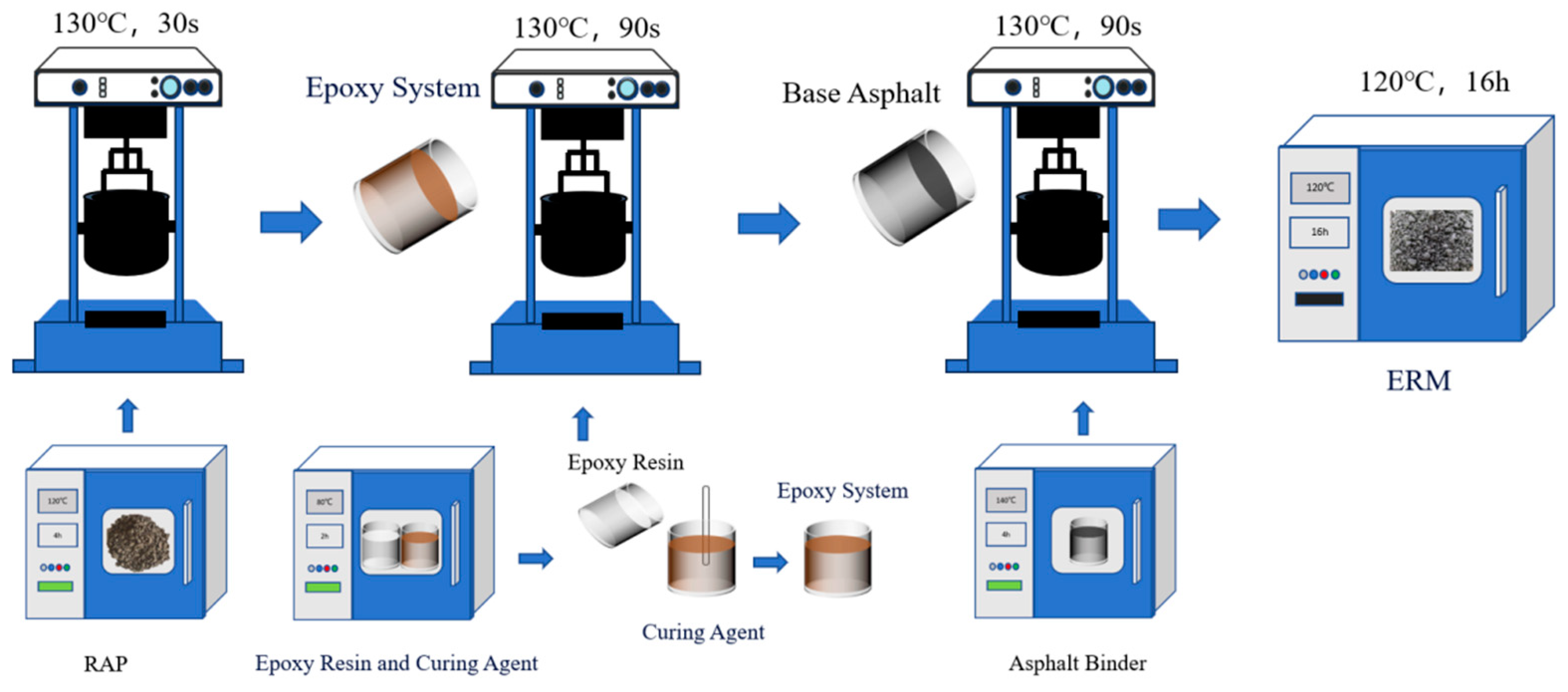
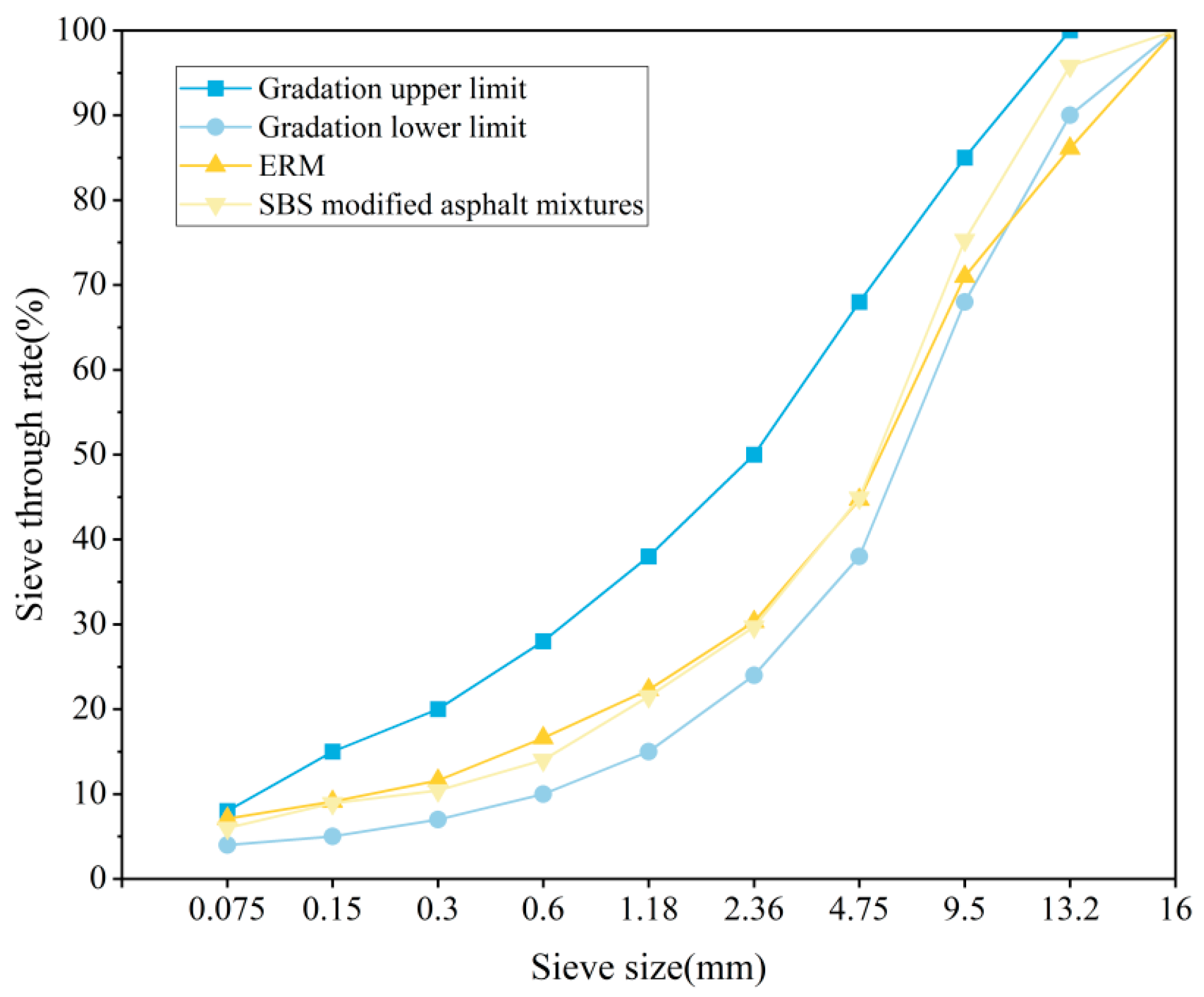

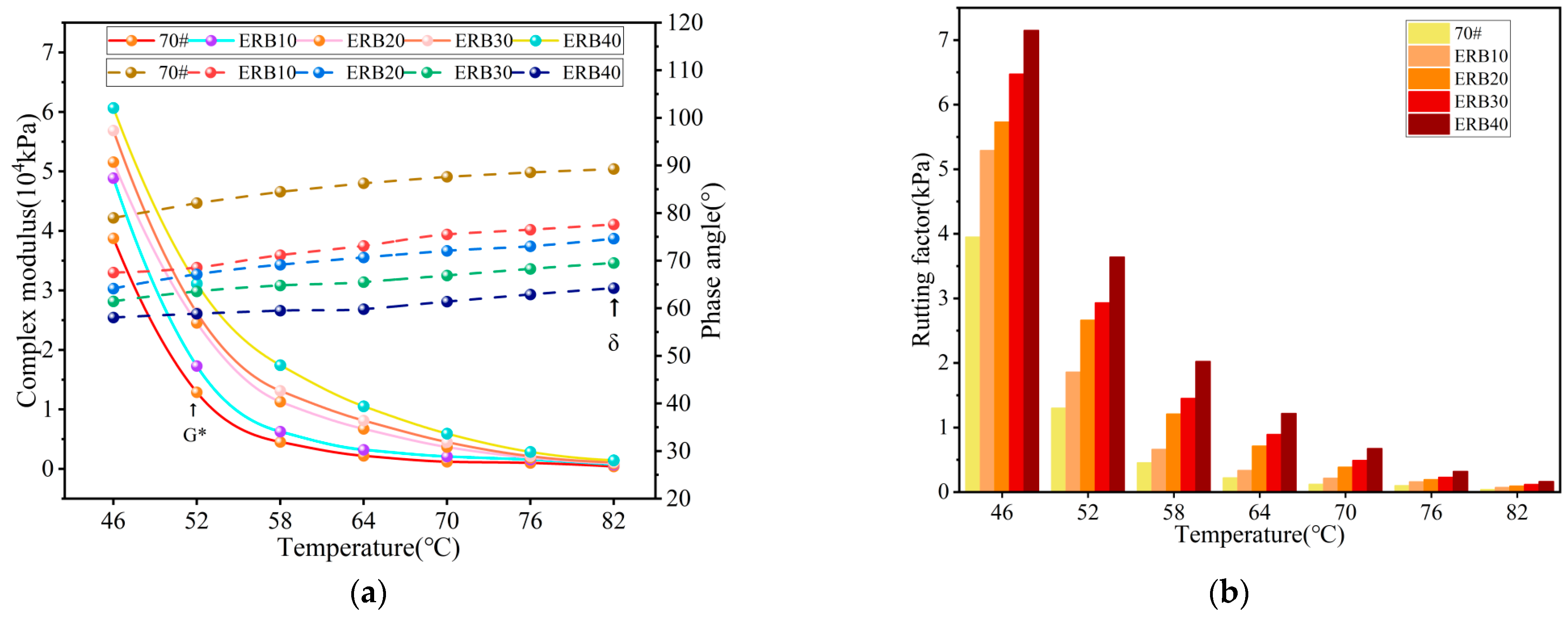
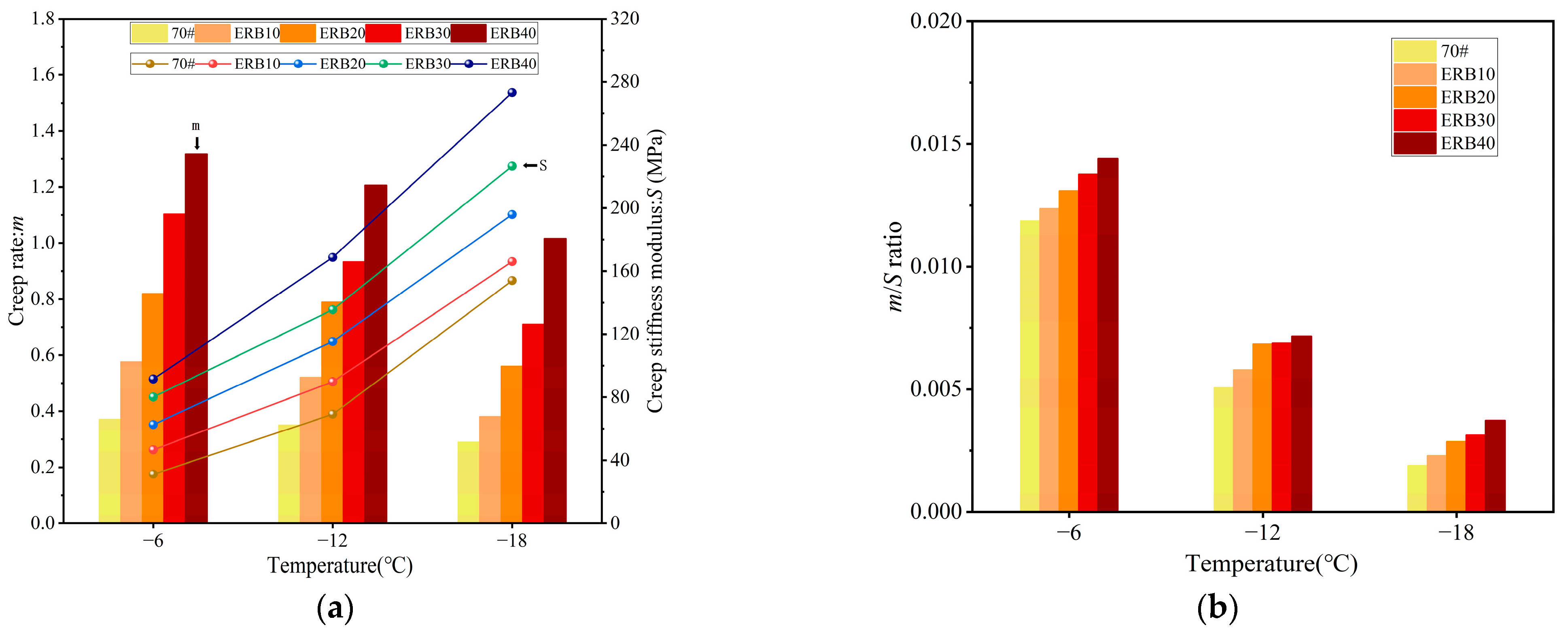

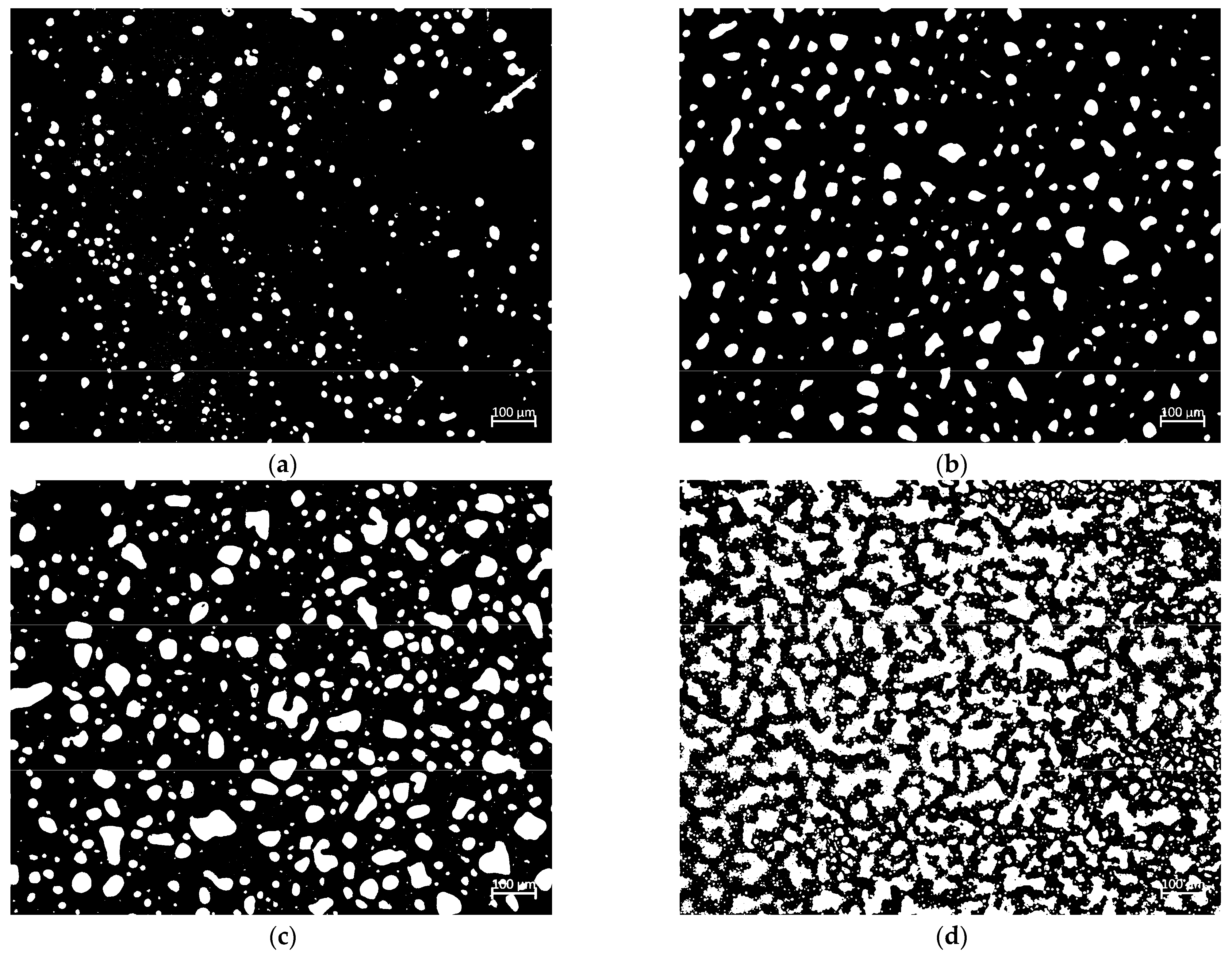
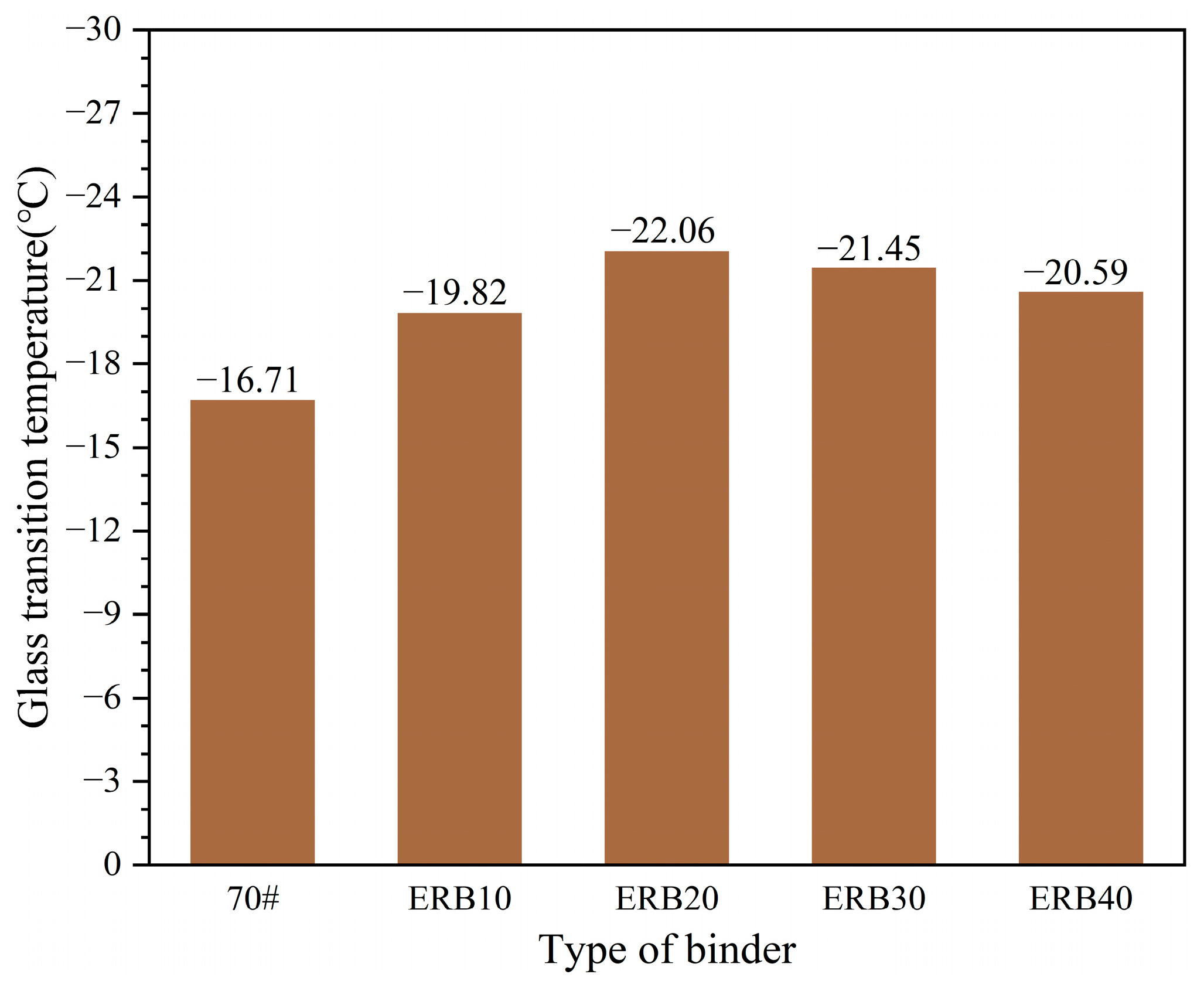
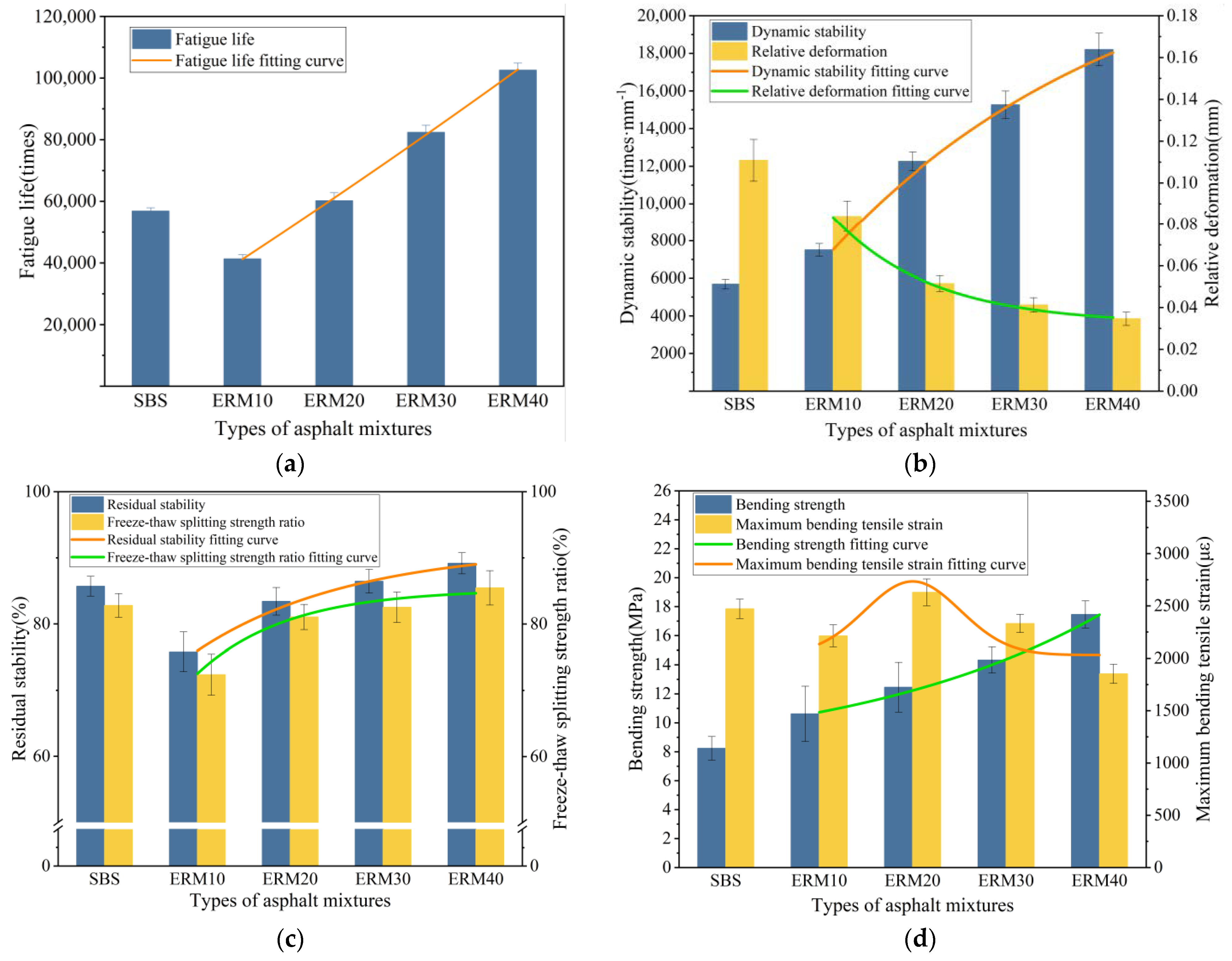
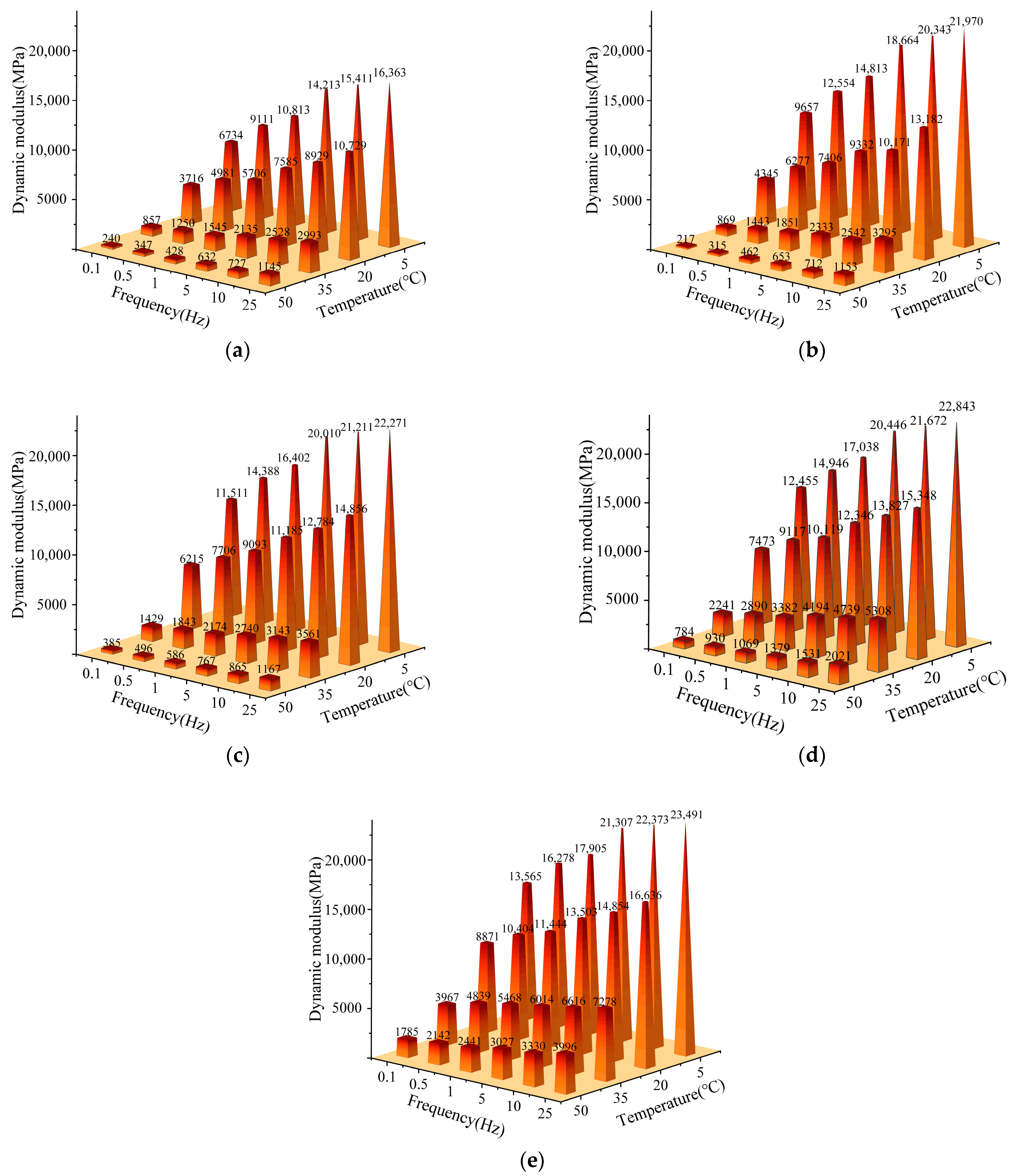
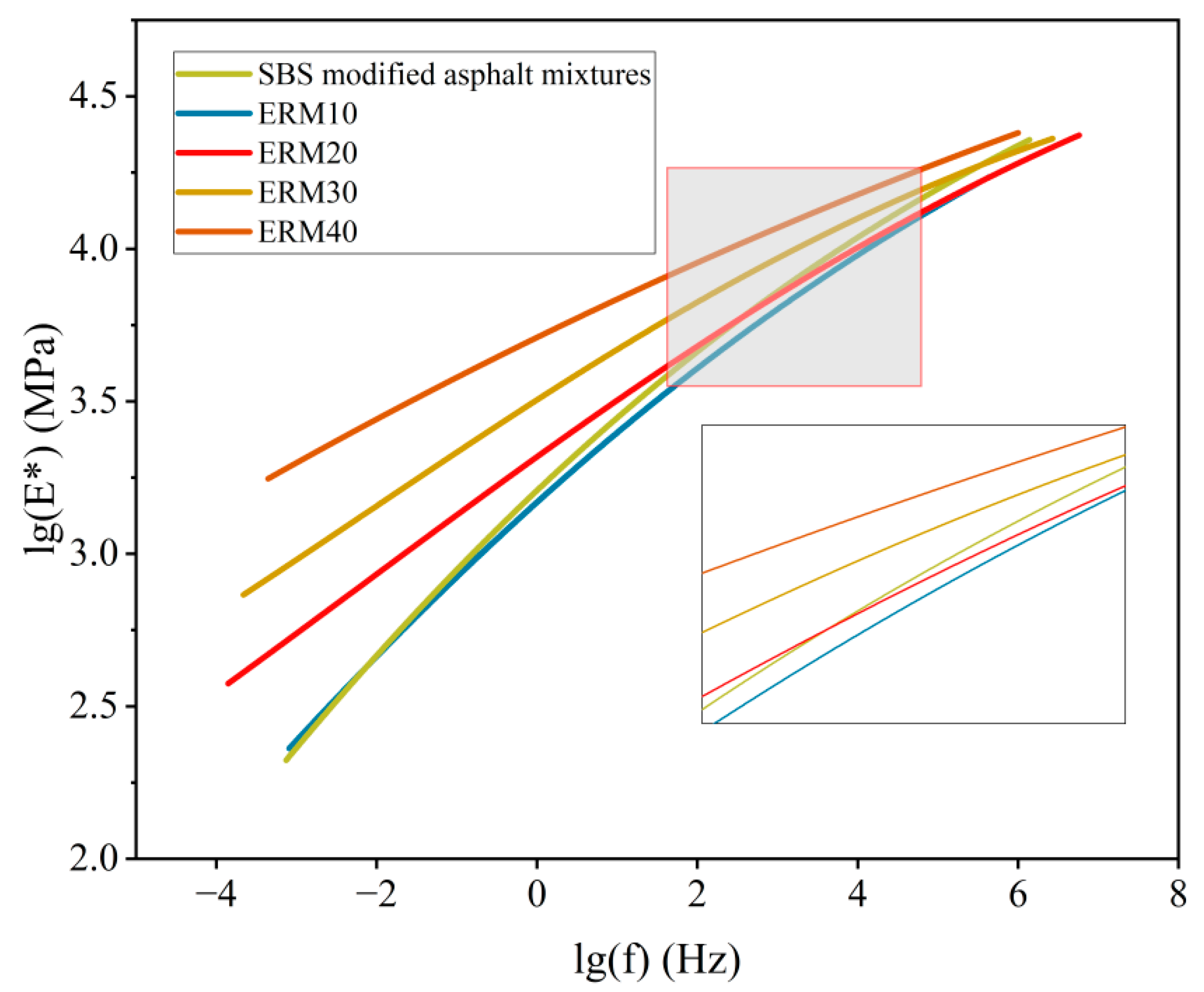
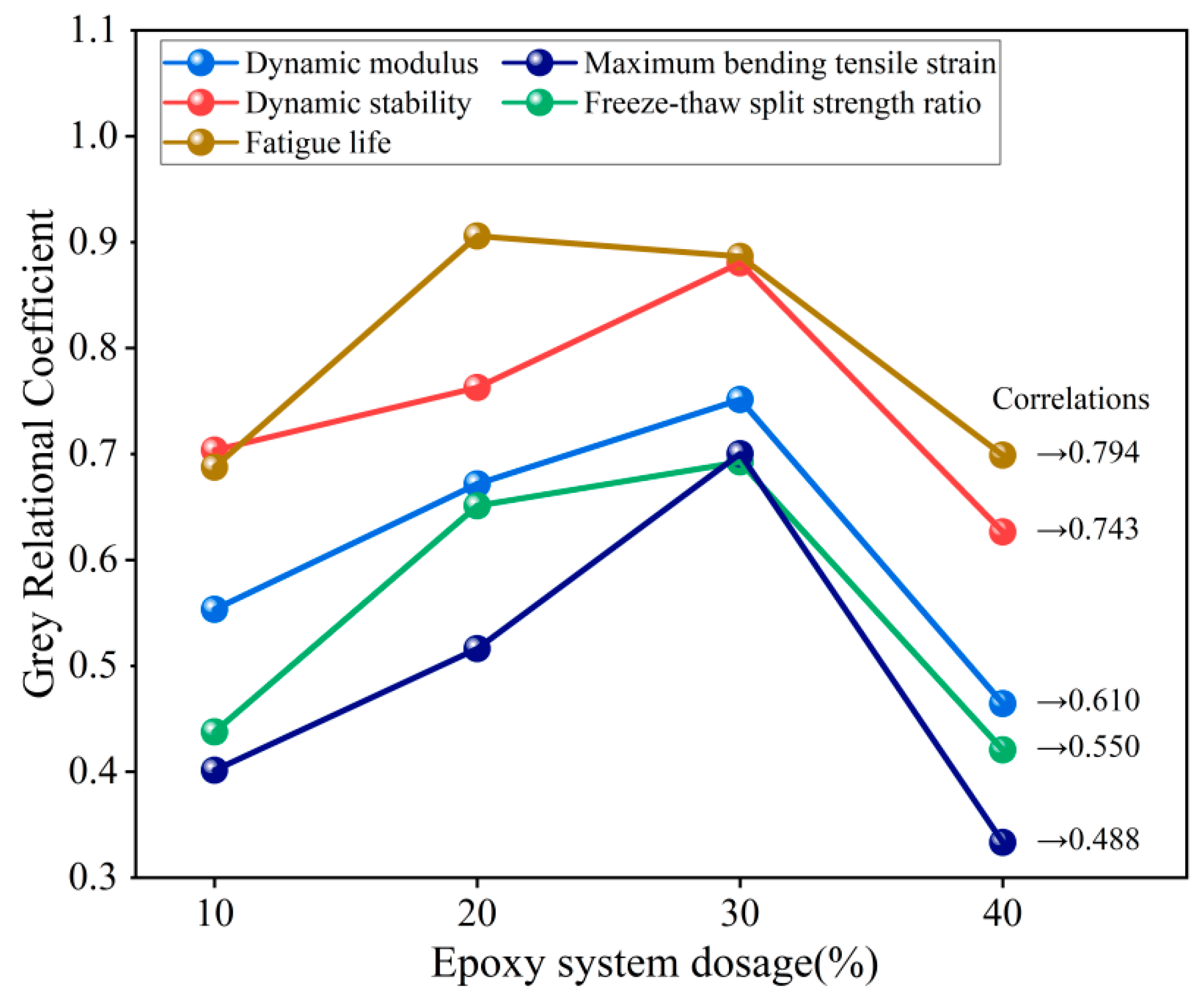
| Components | Experiment Index | Unit | Test Results |
|---|---|---|---|
| Component A | Viscosity(25 °C) | Pa·s | 1.8 |
| Epoxy equivalent | / | 209 | |
| Specific gravity(25 °C) | / | 1.15 | |
| Appearance | / | Colorless transparent liquid | |
| Component B | Viscosity(25 °C) | Pa·s | 5.2 |
| Specific gravity(25 °C) | / | 0.89 | |
| Appearance | / | Amber liquid |
| Physical Performance Indicators | Test Results | Test Methods | |
|---|---|---|---|
| SBS-Modified Asphalt | 70# Matrix Asphalt | ||
| Penetration (25 °C, 0.1 mm) | 52 | 71 | JTG E20-2011 T 0604 [35] |
| Softening point (°C) | 86.2 | 47.0 | JTG E20-2011 T 0606 [35] |
| Ductility (15 °C, cm) | 31 | >100 | JTG E20-2011 T 0605 [35] |
| Viscosity (135 °C, Pa·s) | 3.250 | 0.441 | JTG E20-2011 T 0625 [35] |
| RAP | The Pass Rate of the Following Sieve Holes (%) | Oil–Rock Ratio (%) | |||||||||
|---|---|---|---|---|---|---|---|---|---|---|---|
| 16 | 13.2 | 9.5 | 4.75 | 2.36 | 1.18 | 0.6 | 0.3 | 0.15 | 0.075 | ||
| Coarse aggregate | 95.0 | 78.6 | 55.4 | 24.9 | 17.0 | 13.2 | 10.6 | 7.9 | 6.2 | 4.8 | 2.00 |
| Fine aggregate | 100 | 100 | 100 | 81.4 | 55.1 | 39.1 | 27.7 | 18.5 | 14.4 | 11.5 | 4.58 |
| Parameter Indicators | Penetration (0.1 mm) | Softening Point (°C) | Ductility (10 °C, cm) |
|---|---|---|---|
| Test value | 40.3 | 50.3 | 9.1 |
| Items | Unit | Data | |||
|---|---|---|---|---|---|
| Filler | 0–5 mm | 5–10 mm | 10–15 mm | ||
| Crushing value | % | / | / | / | 14.5 |
| Needle and flake content | % | / | / | 17.2 | 12.2 |
| Apparent relative density | / | 2.721 | 2.773 | 2.890 | 2.751 |
| Gross volume relative density | / | / | / | 2.750 | 2.712 |
| Water absorption | % | / | / | 1.21 | 0.41 |
| Oil–Rock Ratio (%) | Type of Recycled Mixtures | Newly Added Binder Group Ratio | Mixing Ratio of Old and New Binder After Mixing | |
|---|---|---|---|---|
| Epoxy System: Asphalt | Epoxy System: New Asphalt: Old Asphalt | Epoxy System: (New Asphalt + Old Asphalt) | ||
| 2.00 | ERM40 | 98:2 | 40:1:59 | 40:60 |
| ERM30 | 73:27 | 30:11:59 | 30:70 | |
| ERM20 | 49:51 | 20:31:59 | 20:80 | |
| ERM10 | 24:76 | 10:31:59 | 10:90 | |
Disclaimer/Publisher’s Note: The statements, opinions and data contained in all publications are solely those of the individual author(s) and contributor(s) and not of MDPI and/or the editor(s). MDPI and/or the editor(s) disclaim responsibility for any injury to people or property resulting from any ideas, methods, instructions or products referred to in the content. |
© 2025 by the authors. Licensee MDPI, Basel, Switzerland. This article is an open access article distributed under the terms and conditions of the Creative Commons Attribution (CC BY) license (https://creativecommons.org/licenses/by/4.0/).
Share and Cite
Tian, J.; Guo, D.; Xu, Q.; Wu, J.; Sun, X.; Wang, L.; Riccardi, C. Comprehensive Performance Evaluation of Epoxy Reclaimed Asphalt and Mixtures. Materials 2025, 18, 982. https://doi.org/10.3390/ma18050982
Tian J, Guo D, Xu Q, Wu J, Sun X, Wang L, Riccardi C. Comprehensive Performance Evaluation of Epoxy Reclaimed Asphalt and Mixtures. Materials. 2025; 18(5):982. https://doi.org/10.3390/ma18050982
Chicago/Turabian StyleTian, Junhao, Dedong Guo, Qi Xu, Jiang Wu, Xupeng Sun, Li Wang, and Chiara Riccardi. 2025. "Comprehensive Performance Evaluation of Epoxy Reclaimed Asphalt and Mixtures" Materials 18, no. 5: 982. https://doi.org/10.3390/ma18050982
APA StyleTian, J., Guo, D., Xu, Q., Wu, J., Sun, X., Wang, L., & Riccardi, C. (2025). Comprehensive Performance Evaluation of Epoxy Reclaimed Asphalt and Mixtures. Materials, 18(5), 982. https://doi.org/10.3390/ma18050982







